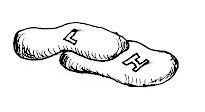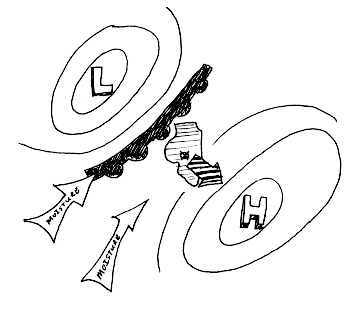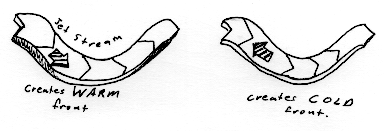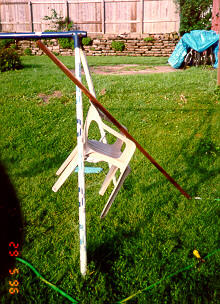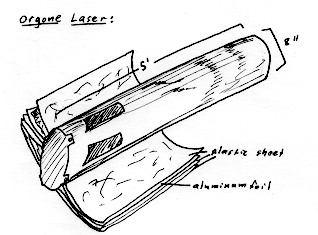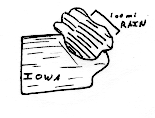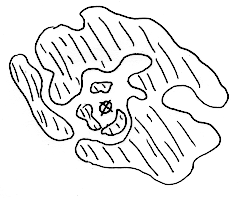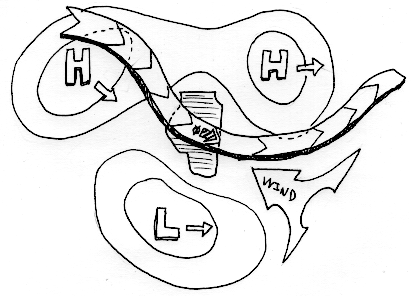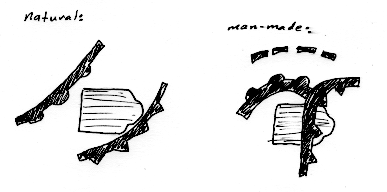Cloudbusting: Macrobusting
montalk 10/11/98
all rights reservedPart II: Macrobusting (back to Part I: Microbusting)
Whereas Microbusting details theories and protocols pertaining to the alteration of local meteorological phenomena, Macrobusting involves spawnings of entire weather systems beyond the horizon.Such weather systems owe their existence to low and high pressure air masses, seen as a blue "H" and red "L" on the typical weather map. By engineering a high pressure air mass (Hp) at a particular geographic location, disturbances such as warm or cold fronts, cool and dry or warm and moist air, lake-effect snow, monsoons, Alberta Clippers, and anomalies as omega-blocks, cut-offs, or hyper-latitudinal jet-streams can be created.
Because these systems appear at great distances from the cloudbuster (CB), it is evident that the ions responsible for local cloudbusting work play little part in Macrobusting. Although the butterfly-effect is still in force when altering a region of the nation's weather, radionic principles play a greater part than do electrical ones.
First, let's analyze how Hp's and Lp's (low pressure systems) are formed by a CB, from an orgonomic perspective. As has been stated, high densities of orgone are accompanied by high concentrations of water (rain is the most obvious form), low densities by low water concentrations bringing about dry, blue skies. Under common knowledge, Hp's bring lear skies, and Lp's cloudy ones. Thus, we can conclude that Lp's are infact dense regions of orgone, and Hp's areas of rarefied orgone. Furthermore, CB's "draw" orgone from any point at which it is aimed, leading to the following principle:
An Hp forms in the direction a CB is aimed. Since orgone flows from low potential (density) to high potential, if a CB is aimed eastward, for example, and lowers the potential of eastern skies, then the atmospheric orgone stream, which normally runs in the same direction as the jet-stream, stops, reverses, and flows westward to its source, streaming away from the area of low potential. However, western portions of the orgone stream beyond influence of the CB are still flowing W to E. As this portion meets with the reversed stream, a damming effect occurs by which an enormous potential of orgone is created west of the CB (see diagram below). Because high potentials of orgone are associated with precipitation, storms spontaneously materialize west of the CB, which, once the W to E orgone flow overpowers the reversed flow, begin to move eastward again over the CB and surrounding regions in sheets of rain.
This former theory, which has proven its validity through countless successful weather operations, can be simplified if viewed from a strictly meteorological point, namely that visualizing reversals of the orgone stream (which is vital for the radionic aspects of cloudbusting to function properly), one simply concentrates upon Hp's, Lp's, and their respective airflows.
Because "high" and "low" are relative terms, one cannot have a "high" without having a "low" pressure system. An Hp is always accompanied by an Lp. More specifically:
An Lp forms in the opposite direction a CB is aimed. If one aims east, an Lp forms west. To fully understand the dynamics of pressure systems, one must realize that in the northern hemisphere:
Hp's rotate clockwise (cw) and Lp's rotate counter-clockwise (ccw) Wherever a CB is, an Hp forms which rotates cw due to corriolis forces (the same force that makes water in your sink rotate cw) and picks up moisture from bodies of water in the path of its winds. Experiments have shown that with distances that Hp's form away from a CB, the wind generated by such a system originates 90 degrees cw from a CB's aim:
And thus the following protocol is discovered:
Draw 90 degrees ccw from the desired wind flow direction For example, if one were in Illinois and requires a moist, southerly warm air flow from the Gulf of Mexico, the CB would be pointed east, for east is 90 degrees ccw from south. Of course, 90 degrees is not a critical number; infact, as will be stated later, a an hour-long "sweep" from 70 to 90 degrees ccw with a CB is an effective method of creating large Hp's. However, please attempt to keep aim within this range, otherwise accuracy will suffer dearly.
Now let us discuss warm and cold fronts. Warm fronts occur when(assuming weather normally flows from W to E accross a region) an Lp west of a location collides with and overruns an Hp:
Because the moist, warm, low pressured air is "lifted" to higher altitude where temperatures are considerably cooler, the Lp's air must also cool. Since cooler air cannot hold as much moisture as warmer air per unit volume, the moisture must condense to a form more commonly known as rain or snow. The boundary between the air masses in such a case is a warm front.
Conversely, a cold front is established when an Hp approaches an Lp from the west, and digs beneath it with the same lifting effect. This is rightly called a cold front.
Combining diagrams of direction of draw, source of moisture, resulting Hp and Lp, and front gives us the following diagram:
As is evident by the diagrams, a cold front is engineered by aiming the CB into the main weather flow, and a warm front by pointing away.
How does one determine the "weather flow" described above? Visually, one may observe cloud movement or direction of wind, but be aware that oftentimes clouds of different altitudes move at separate directions. What we must be concerned with is the motion of storms in general. It is known that storms follow the jet-stream in their trek accross the country. Thus, it is best to consult weather maps of the current jet-stream to know in which direction one should draw.
In summary of fronts and their relation to Macrobusting:
Warm fronts are created by aiming away from the jet-stream's path of flow, and will follow the direction of the stream once created. Cold fronts are created by aiming into the jet-streams's path of flow, but will also follow the direction of flow once created.
But what happens when the CB draws in a direction not parallel to the jet-stream? The jet-stream then actually changes its course to become parallel:
Don't expect to ever reverse the direction of a jet-stream. At most, you will either create a "cut-off" or an "omega-block":
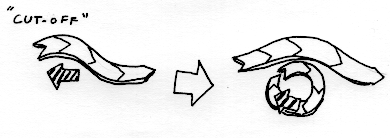
Now that we know in what direction to aim, there are several other factorss to take into account: the elevation of aim, strength/geometry of the CB, duration of draw, and sweep of aim.
First, the elevation in part determines range. A water powered copper pipe such as the following,
aimed at 20 degrees above horizon can be expected to create an Hp with center located almost 500 miles from the draw site. At 45 degrees, range reduces to 200 miles. But since Hp's and Lp's are 100's of miles in diameter, even a long-range CB has power to influence local weather, albeit indirectly. A long range is useful for engineering massive Hp's west or NW of a location, which results in a quick, powerful, cold front storm followed by several days of sunshine and cooler weather.
Due to storm systems moving rather quickly to the east, when making warm fronts (east draw) care must be taken to use short-range aim, since if an Hp is formed too far east, so will the warm front, overshooting the target location by many miles and bringing rain to places that do not need it. Therefore:
For cold fronts, aim low on horizon and into the jet-stream. For warm fronts, aim halfway to zenith and down the jet-stream. Second, the construction of a CB is obviously of critical importance and affects the range at which Hp's are formed. The following list of devices are arranged by order of decreasing range:
1)Long, 12' gutter pipes, water-powered, set up in rack formation.
2)Single or double copper pipes, 10' by 2", water powered.
3)Orgone laser (described below), dry
4)Furnace pipe, 5ft by 6 - 8 ", water powered.
5)Orgone volcanoes.
6)Trevor James Constable's geometric devices.
7)Ion guns.
Numbers 1 - 4 are best for Macrobusting, and 5 - 7 for Microbusting. Geometry plays an integral role in TJC's equipment, but that is beyond the scope of this article. TJC has been extremely careful about what information he divulges to the public concerning some of his CB's, such as the use conical shapes and the golden ratio combined with rotary motion in his more secret devices. Because I have not successfully replicated these devices for lack of information, I cannot offer advice to the reader concerning this matter.The orgone laser has been my primary tool and works well as a long-range waterless CB. It consists of a 5' by 8" sheet metal furnace pipe (available cheaply at your local hardware store), whose end is covered with a sheet metal backplate rivetted in place. Windows are cut at 1/4 distance up from the bottom, and an orgone matt made of alternating plastic and aluminum foil sheets (with aluminum on the inside and plastic on the outside) is wrapped around the lower half and duct-taped securely:
Third, duration of draw is the most important of all factors, It decides the difference between a massive hailstorm and gentle rain. For long-range water-powered, it is recommended by experienced CB operators that one draw no longer than one hour. This is critical. For the orgone volcano and laser, which are more experimental, I have found a draw time of several hours as safe. Occasionally, they were in place overnight without severe consequences, unless the tornadoes in Texas were the effect (which I seriously doubt since the range would've had to have been 700 hundred miles). When trying novel devices built at home, try them for no longer than 1/2 hour the first attempt, then increase duration the next week and observe the effects if all went well the first time. It is esciting to observe radar spots of red on the TV screen, but always be aware of the mortality that goes along with it. How much is a life worth at the expense of your foolery? Think twice before drawing double the norm just to see an overkilled hit being spoken about on the six-o'clock news. (I have done this accidentally once, but never again)
Lastly, sweep of aim controlls the cross-span of an Hp. By sweep it is meant the periodic repositioning of a CB muzzle to sweep an arc accross the sky over duration of draw (by the way, "draw" is an old lable where orgone is thought to be "drawn" into a pipe and directed with a "sweeping motion." With my ion model, it is more likely that ions are shot from the pipe, but both explanations can bring weather operations to fruition). For example, one may position a CB south-east. Then, after 5 minutes, the muzzle is shifted left or right by an increment equal to the arc divided by the number of repositionings (see diagram below). Sweeps can be made horizontally or vertically. Horizontal sweeps broaden the Hp's span, and vertical sweeps better reverse the orgone stream , or, if one preffers my point of view, creates a more dense Hp, and thus better storms. Vertical sweeps should be raised no higher than 45 degrees above horizon, otherwise inaccuracy will result.
Once a CB session is completed, one can expect to observe the following: 1) 18 - 22 hours after the session's mid-point, a small patch of rain roughly 100 miles in diameter moves accross the region without the presence of a front:
At this point the weather map may show signs of an occluded front (purple dashed line) forming 500 miles opposite of draw. The small patch of rain gives about .15 inches of precipitation in most locations except near the site of draw. Because the air is still litered with an overabundance of ions due to Micro-effects, the patch of rain disintegrates above, but re-forms once it passes:
You will also note that on a sunny day with cumulus clouds abound, such clouds will also disintegrate and start to "shred" above. This is classically blamed on DOR or ORANUR, but it is really due to extreme levels of ion density (remember that ORANUR is orgone energized by radioactivity, and that radioactivity ionizes air, hence the term "ionizing" radiation, showing that air ionized by a radioactive material coupled with a radionic element is equivalent to ORANUR).
One to two days after this rain patch moves through, the occluded front will have transformed into a prominent warm front which will finally trek eastward and bring lots of precipitation to the target area, including the draw site (if you empty a bucket of water above an ion generator, the water will soak it. Likewise, a warm front will overpower any residual ions left in the CB area. Also, the extra two days allowed for ionized air to be thoroughly ventilated and diluted.)
If, however, the CB was aimed incorrectly and not parallel to the jet-stream, the bulk of precipitation will land north or south of the target site.
Now, to give the reader a better idea of how to go about cloudbusting, a thorough example of a typical CB session is given. The CB operator is located in middle Illinois, which is currently under the influence of a high pressure system to the NE, with SE winds at a gentle breeze. A low pressure area is south, and due to move east quickly, with more high pressure from the NW expected to bring no precipitation for the next five days. Temperatures are in the upper 80's and the humidity is at 65%:
The CB operator decides to bring a premature rain to the region in the form of a warm front, and observes the jet-stream over his location from NW to SE. Therefore he chooses to aim his CB south east, away from the jet-stream to get a visible hit on his own location. The Lp and Hp in place will move out soon to be replaced be the HP north west, but by creating a new Hp southeast of the site (in direction of aim), an Lp will inherently form NW, either replacing or modifying the predicted Hp.
He utilizes two units, a 10' by 2" copper pipe and an orgone laser. After propping both pipes up on lawn chairs at 30 degrees above horizon, he inserts a misting spray nozzle in the copper pipe's end. The copper pipe is swept from 15 degrees left to fifteen degrees right of SE at intervals of five minutes. The laser is positioned low on the horizon to be swept vertically upward to 45 degrees over the same duration as the copper pipe, an hour's long draw. After an hour, the copper pipe is disconnected and stored, but the laser is repositioned to its original aim 15 degrees above zero. Later that evening, it, too, is put away.
Twenty hours later, in the early afternoon of the next day, radar shows a frontless patch of rain approaching and overtaking the area, but the CB site receives only sprinkles for less than twenty minutes. (the patch of rain is less than 100 miles accross, otherwise it must have moved at 300 mph, which is impossible). This is the first wave of precipitation, already forcing a contradiction of the weather man's predictions.
Over the next two days, an occluded front is observed to spawn and develop in north Dakota and an Lp is seen arising where the former Hp was. At the end of two days, a warm front has developed, sending moisture from the Gulf into Illinois for a span of fourteen wet hours(see new weather map below). Mission accomplished.
Of course there are many variations on this theme, but it gives good insight as to what one can expect when Macrobusting. But don't forget that what is west, must go east, and all storms running over Illinois do not just "disappear" once the pass the state. They gather in strength as the move eastward, soaking those in the East Coast, particularly in Virginia and North Carolina with the example given. It doesn't take a tornado for one to know that his CB works, so do not attempt this.
Here is more advice:
To create cooler weather draw westward; this allows a Hp to form west, channeling in cool air from the north.
To break a drought, find large body of water such as the Gulf, the oceans, or the Great Lakes, and aim the CB 90 degrees ccw from that direction. Winds will cary moisture from those sources and dump it on the target location.
To clear an overcast sky (a Microbusting protocol), set up as many pipes as possible in a tub pointing at all skyward directions, and flood the tub with water, or use one pipe and sweep from the zenith to horizon in a helical manner, stopping for several seconds every twenty degrees rotationally, then repeat until sky is clear.
To make it snow, wait for cold temperatures, and follow the same direction as in breaking droughts, except allow the moisture source to clash with cold air over the target location. Snow fall accumulations are a good way of measuring your accuracy, since incorrect alignment will give snow in a streak north or south of your desired site. The only hard part is using a water hose at subfreezing temperatures, unless you use a waterless unit. Don't forget the brutality of blizzards and fatal traffic accidents that come with it, so don't overdo it.
Lastly, to check if a front on the current map is natural or man-made, one should observe the smoothness and continuity of fronts. If they are rounded and simple, chances are that they came from natural sources. However, if they appear broken and malformed, they are man made (see below). This is most obvious in the summer months. Also look for steady streaks of clouds in the satellite loops, for they indicate evidence of Microbusting.
This ends our discussion on cloudbusting in its typical forms. If the reader chooses to try any of the material herein, he is advised to learn an adequate knowledge base on meteorology and orgonomy before starting. Reading orgonomy-related books and watching the Weather Channel for a couple months should suffice, unless one were to employ himself in proffessional cloudbusting, in which case many years of study and experience are recommended. Because the sky is finite, other CB operators may be performing their own experiments on the same portion of it, unaware of one another. Then they wonder why the results went contradictory to their expectations. It's best to always document one's proposed operation at a public forum such as PORE's cloudbuster forum, so that other CB operators in the area know to refrain from getting out their equipment in the same week.
There is much more to be discovered in the diverse variations of cloudbusting, and while the government is breaking its back trying to change the climate with megawatts of microwave power as in the HAARP project, you can accomplish ten times over what they can in the leisure of your own back yard using the gentle principles of nature discovered by the great Wilhelm Reich. Good experimenting to all!
www.montalk.net


